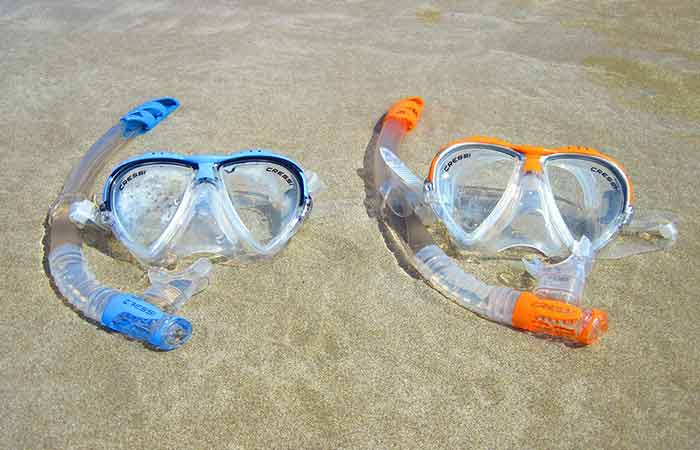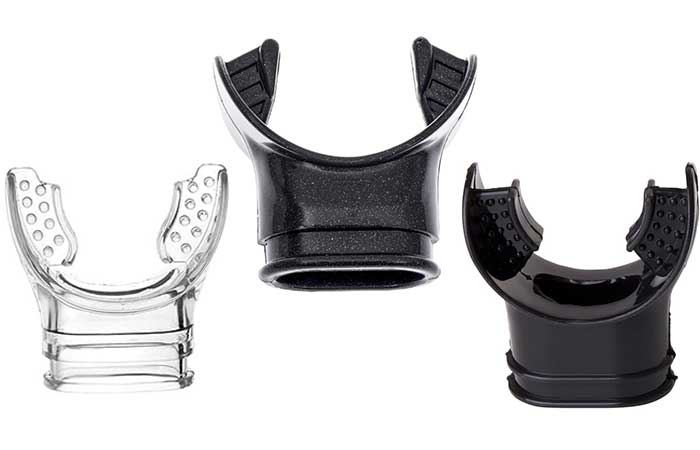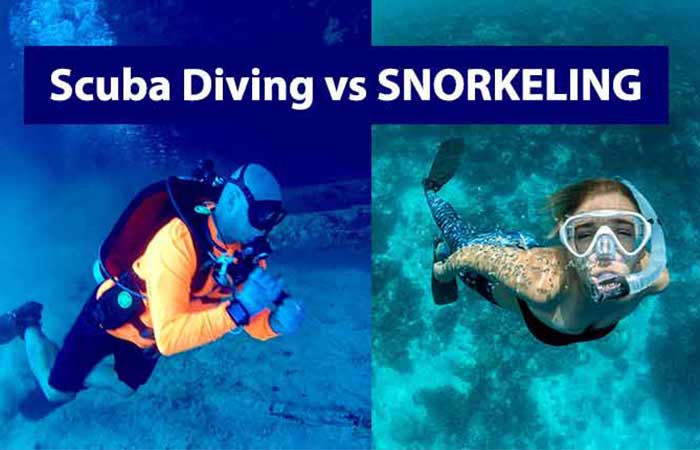Full Face Snorkel Mask vs Regular/Traditional Masks
Snorkel masks have evolved and improved significantly over the years. In the past, snorkelers used regular snorkel masks for their underwater adventures. However, the snorkeling world has been revolutionalized since the early 2000s, when full-face snorkel masks were invented.
The main difference is that a full-face snorkel mask combines a snorkel and a mask into a single surface-snorkeling piece that covers the entire face while regular masks covers a portion of your face; nose, and eyes ideal for deep dives. While full-face masks are bulkier and usually for beginners, regular masks are lightweight and mostly preferred by advanced snorkelers.
Following is a detailed discussion of the differences between these two types of masks and their characteristics, advantages, and disadvantages. We will also assist you in determining which sort of mask is ideal for you and your snorkeling requirements.
| Feature | Full-face snorkel masks | Regular snorkel mask |
| Number of Pieces | All-in-one (Snorkel and Mask in one) | Two pieces (separate Snorkel and Mask) |
| Equalization | Most have no mechanism to equalize | Equalization mechanism available |
| Comfort and fit | More comfortable for extended use | Less comfortable for extended use |
| Visibility (field of view) | 180 degrees view | Limited field of view |
| Depth of diving | Shallow dives | Can be used for both shallow and deep dives |
| Transitioning to diving(free/scuba) | Difficult | Easy |
| AIrflow | Efficient airflow system | Limited airflow |
| Fogging | Minimal | Likely to fog |
| Usefulness | More useful | Less useful |
| Reliability | Less risk of leaks | Prone to leaks |
| Breathing system | Dual (nose and mouth) | Mouth only |
| Safety | CO2 might build-up in the mask | Water might clog the snorkel tube(wet types) |
| Popularity | Gaining popularity | Has been popular for long. It is widely used |
| Price | More expensive | Less expensive |
| Snorkeling experience | Suitable for beginners and children | Suitable for experienced snorkelers, swimmers and divers |
| Water condition | Can be used for both calm and rough water | Can be used for calm waters but the wet snorkels are not preferred for rough water |
| Jaw Fatigue/Soreness | None | It is a common problem when add the snorkel tube -you’ve to bite the mouthpiece |
| Bulkiness | Huge | Light weight |
Differences
Follow are the key features that make full-face and regular masks different
Design
Traditional snorkel masks, come as two separate pieces of gear: a snorkel tube and a mask. You simply slip on the mask which encases your nose and eyes then attach the snorkel to the ring usually found on the left side of the mask straps.
The mask helps with vision underwater, while the snorkel helps with surface breathing. You can opt for a wet snorkel, semi-dry snorkel or a dry snorkel, which stays dry when you free dive to explore further.

A full-face mask comes as a single piece. All you need is to slip it in, adjust the straps and start snorkeling. Modern FFSMs have separate chambers for breathing and viewing. They have silicone edges to help them stick to your face, along with the adjustable straps.

Comfort
Comfort is a critical component of the overall snorkeling experience. The comfort level between a full-face snorkel mask and a regular mask varies significantly.
A full-face snorkel mask is designed to fit you more comfortably because it covers the face with no gaps or openings. This design is helpful, especially for those who have claustrophobia or find traditional snorkel masks uncomfortable. The mask also has a better seal that guarantees no leaks and keeps your face dry.
On the other hand, a regular snorkel mask often provides less comfort because it only covers your mouth and leaves the eyes and nose exposed. Also, holding the snorkel tube in your mouth for an extended period of time can be uncomfortable and lead to problems like jaw fatigue. The seal is less effective than the full face mask, which might lead to leaks near the nose.
Therefore, the full-face snorkel mask is designed to provide a more comfortable fit than the regular snorkel mask.
Convenience
Full-face snorkel masks and regular snorkel masks each have their own set of advantages in terms of convenience.
First, full-face snorkel masks are typically considered to be more convenient since they offer a more comfortable fit and do not require a separate snorkel. Furthermore, they usually feature a broader field of vision, which makes it simpler to observe more of the underwater environment.
Additionally, the integrated breathing system eliminates the need for you to use a separate mouthpiece, making it simpler for you to breathe underwater.
On the other hand, regular snorkel masks are frequently more handy for snorkelers desiring a smaller and lightweight mask choice. They are also more convenient to pack and store with other snorkeling gear, making them perfect for travel.
Experienced snorkelers prefer the regular snorkel mask for the flexibility they get from the separate snorkel tube.
Visibility
Both masks have their own benefits when it comes to visibility.
Full-face snorkel masks provide a broader field of view than regular snorkel masks because they cover the entire face and have a larger lens. This feature helps you view more of the underwater environment, simplifying navigation and spotting marine life.
They also have a clearer lens and anti-fog technology, which helps in improving visibility underwater.
Regular snorkel masks have a smaller field of view. However, this can allow a sharper and more unobstructed view of the underwater environment. They are also more lightweight and compact, which can assist in reducing the drag effects while diving and improving visibility in the water.
Generally, the visibility of a full-face or regular snorkel mask will be determined by personal preferences and water conditions. Some snorkelers enjoy the larger field of view that a full-face mask provides, while others prefer the clarity regular snorkel mask offers.
System of breathing
The two masks’ breathing systems are what differentiates them majorly.
Firstly, full-face snorkel masks allow you to breathe more freely and naturally. They feature a bigger breathing chamber covering your entire face, making it simpler to inhale and exhale from both the nose and mouth. The mask also has a dry-top design that prevents water from entering the breathing chamber.
On the other side, regular snorkel masks allow you to breathe through the mouth. This might sometimes seem uncomfortable and strange, especially for beginner snorkelers. This is because they feature a snorkel tube you place in your mouth while snorkeling.
Furthermore, some snorkel types(wet) are open on one end, allowing water into the breathing tube, which can be uncomfortable or dangerous. You will have to remove the tube from the mouth and spit the water out.
Generally, the breathing system of a full-face mask makes underwater visibility more convenient and safer than that of a regular snorkel mask.
Depth of diving
Snorkeling is a surface activity rather than deep-water diving. Various factors, including your swimming abilities, water conditions, and the mask itself, determine the depth of diving you can achieve while wearing a snorkel mask.
With that said, Full-face snorkel masks are designed for shallow-water snorkeling and should not be used to dive deeper than 10 to 20 feet. This is due to the fact that the mask covers the full face, making it more difficult to equalize pressure and control airflow at deeper depths.
Regular snorkel masks are not limited in the same way as full-face snorkel masks. You can use them for deeper dives because you can easily equalize.
Airflow
The design of full-face and normal snorkeling masks is what causes the masks to have different airflow systems.
In a full-face snorkel mask, the air passes through the snorkel, which is placed at the top of the mask. This ensures a regular and consistent flow of air, allowing you to breathe easier and lower the chance of inhaling water.
In contrast, air goes through a separate snorkel tube linked to the mask in a regular mask. This design is more prone to leaks and limits airflow, making breathing more difficult when snorkeling with the mask. Furthermore, the snorkel tube might become immersed in water, making breathing more challenging and increasing the danger of inhaling water.
Finally, full-face snorkel masks provide a more pleasant and simple breathing system with a consistent and steady flow of air, whereas regular masks are more prone to leaks and have limited airflow.
Price
Full-face snorkel masks typically cost more than regular snorkel masks. This is due to the fact that they are made of more modern materials and have more advanced technologies. They are also more durable, making them a more cost-effective alternative over time for snorkeling.
Compared to regular snorkel masks, which are often less costly than full-face snorkel masks since they are less advanced and have a shorter lifespan. They also lack the advanced features found in full-face snorkel masks, making them less comfortable and convenient to use.
Popularity
Comparing full-face snorkel masks to regular ones based on popularity is a complicated question because it varies on individual tastes.
Some snorkelers prefer full-face snorkel masks because they provide a greater field of view and a more pleasant breathing experience. On the other hand, other snorkelers prefer regular snorkel masks since they are more traditional, easier to use, and less costly.
The popularity of either mask will ultimately depend on the snorkeling experience and also individual preferences.
To summarize, the decision between a full-face and a regular snorkel mask is ultimately determined by your preferences, desires, and comfort. Both masks have their own sets of benefits and drawbacks.
Full-face snorkel masks provide a wider field of view, a unique breathing system, and increased comfort for some people. On the other hand, regular snorkel masks provide better reliability and flexibility while diving deeper.
When making a decision, examine elements like safety, comfort, utility, visibility, breathing system, diving depth, airflow, pricing, and popularity.
Finally, the best mask for you is the one that delivers the most pleasant and safe snorkeling experience. So, take your time researching and find the one that best suits your needs.
More on Snorkeling Masks & Snorkels
- Best Full Face Snorkel Masks
- Full Face Snorkel Mask Dangers, Deaths and Safety Tips
- How to Stop & Prevent Snorkel Mask Fogging
- How to Size Full-face Masks
- Can you Snorkel with Glasses & Contact Lenses?
- Best Prescription Snorkel Masks & Goggles: Full Face+ DIY Guide
- Breathing Underwater with a Full-Face Snorkel Mask
- Snorkeling with Beard/Mustache
- How to Clean a Snorkel Gear: Snorkel Mouthpiece, Mask, and Fins
- How Does a Snorkel Work?
More about Snorkeling
- Snorkeling-Meaning, History, Application Benefits & FAQs
- Do You Need to Know How to Swim to Snorkel
- How to Snorkel Safely: Beginner, Non-Swimmer & Advanced Snorkeling Guide & Tips
- How Much Does it Cost to Snorkel??
- Top Snorkeling Quotes, Funny Puns & Jokes for your Captions
- Snorkeling Vs Scuba Diving: Differences & Similarities
- Can You Snorkel while Pregnant?
- Complete Snorkeling Gear Guide: Choose the Perfect Equipment for Your Next Underwater Adventure






